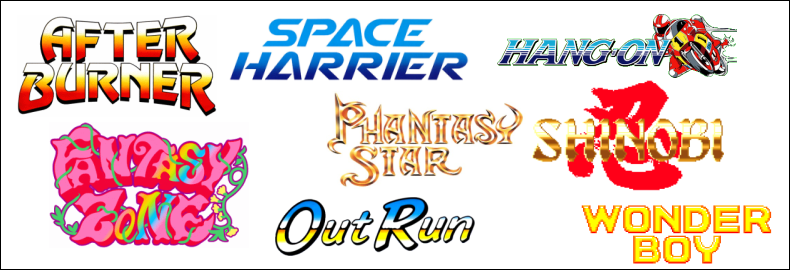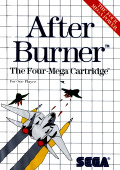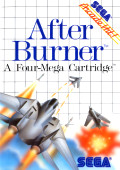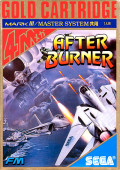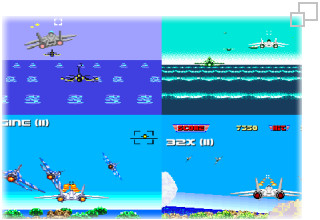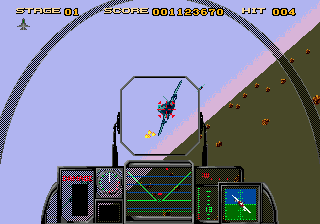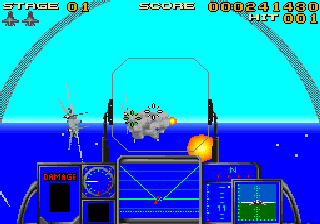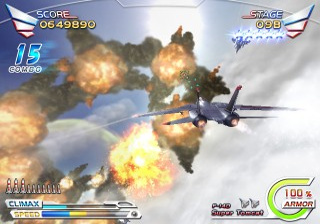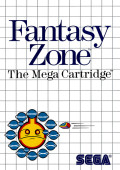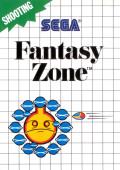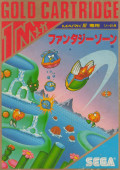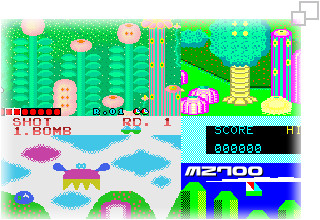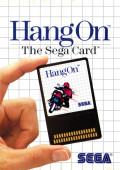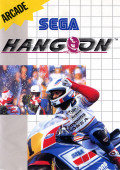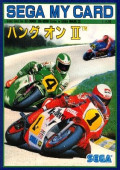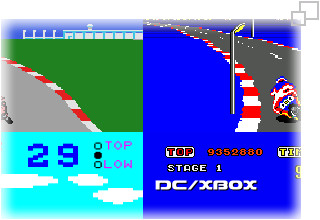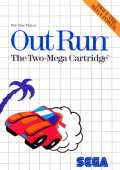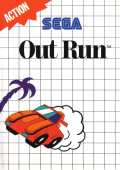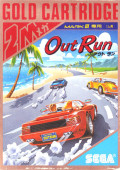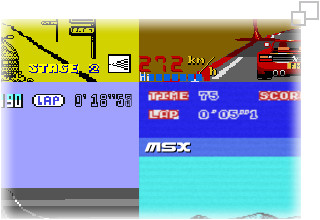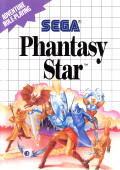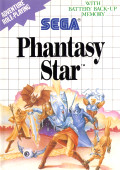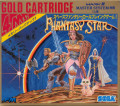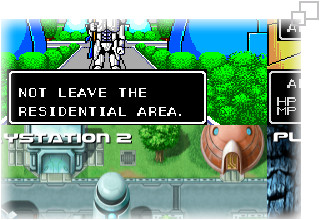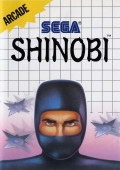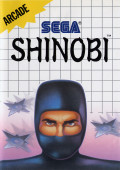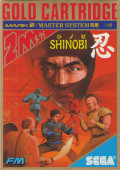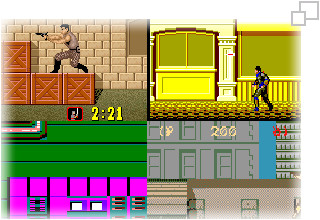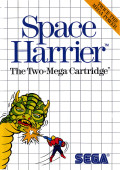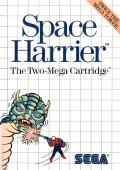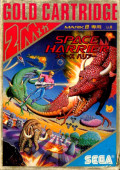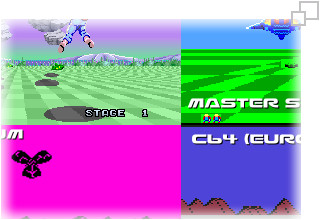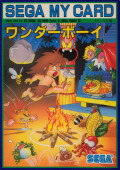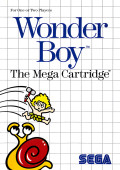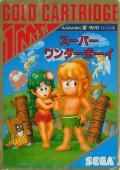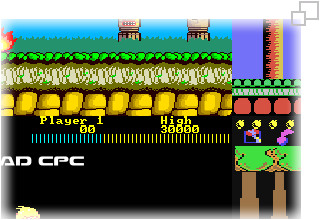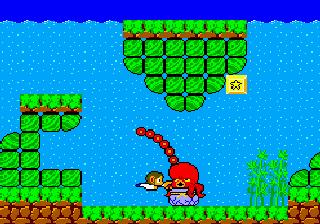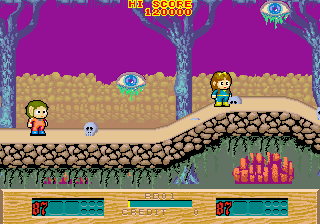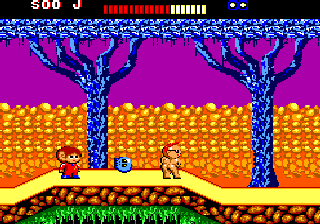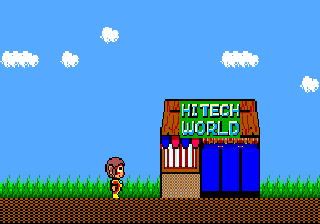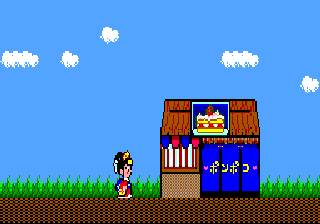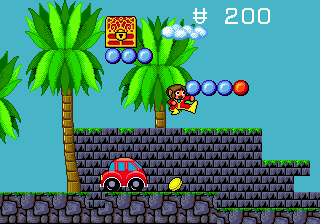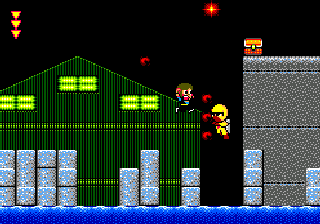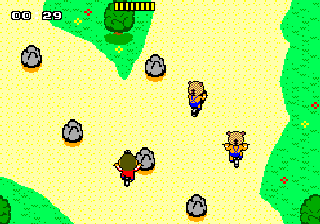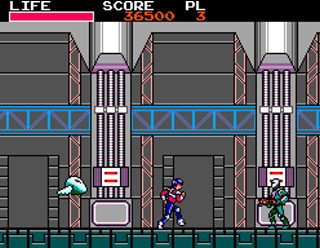Start | Specials | SEGA´s Firsts
Mit dem Master System (viel mehr als mit der SG-1000 Konsole) konnte SEGA zumindest annähernd seine hervorragenden Marken aus der Arcade wie Out Run, Shinobi oder After Burner zum ersten Mal dem Massenmarkt präsentieren.
Doch was wäre gewesen, wenn die Erstlingswerke auf dem SG-1000 oder Master System schlecht programmiert worden und gefloppt wären oder die zumeist arcadelastige Spielweise auf den Heimgeräten nicht funktioniert hätte?
Hier geben wir euch einen Einblick in die ersten Teile mittlerweile berühmter Spieleserien und was nach ihnen folgte. |
After Burner
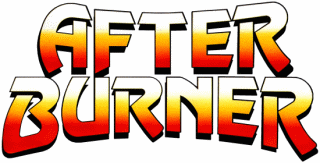
 = schlechte Umsetzung = schlechte Umsetzung  = ziemlich schlechte Umsetzung = ziemlich schlechte Umsetzung  = ziemlich gute Umsetzung = ziemlich gute Umsetzung  = gute Umsetzung = gute Umsetzung  = sehr gute Umsetzung = sehr gute Umsetzung
Fantasy Zone
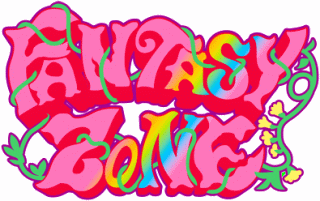
 = schlechte Umsetzung = schlechte Umsetzung  = ziemlich schlechte Umsetzung = ziemlich schlechte Umsetzung  = ziemlich gute Umsetzung = ziemlich gute Umsetzung  = gute Umsetzung = gute Umsetzung  = sehr gute Umsetzung = sehr gute Umsetzung
| First |
Umsetzungen |
Screenshot Comparison |
Auch wenn der Master System Port von 1986 gleichzeitig nur 32 Farben im Gegensatz zur Arcade-Version des System 16A Boards mit 256 gleichzeitigen Farben darstellen kann und einige Kleinigkeiten wie das Parallax-Scrolling oder die Hintergründe bei Bosskämpfen verschwunden sind, schafft es die Umsetzung doch recht gut, das Spielgefühl hervor zu rufen.

Das knallbunte Spektakel erscheint zwar immer wieder mal auf Compilations neuerer Systeme, lässt aber im Gegensatz zu den weiteren SEGA-Marken einen wirklichen Nachfolger bzw. eine Neuauflage vermissen. Das wirklich sehr gute Super Fantasy Zone auf Mega Drive ist nun auch mittlerweile weit über 20 Jahre alt. |
Fantasy Zone
Famicom (1987) 
MSX (1987) 
Sharp MZ700 (1987) 
PC-Engine (1988) 
NES (1989) 
X68000 (1989) 
Wii (2008) [MS Version] 
Fantasy Zone Gear [edited MS Version]
Game Gear (1991) 
SEGA Ages: Fantasy Zone [Arcade Ver.]
SEGA Saturn (1997) 
SEGA AGES 2500 Vol.3 [Polygonal]
PlayStation 2 
SEGA AGES 2500 Vol.33 (Complete Collection) [Arcade Ver.]
PlayStation 2 (2008) 
Sonic´s Ultimate Genesis Collection [unlockable Arcade Ver.]
PS3/360 (2009) 
3D Fantasy Zone: Opa-Opa Bros. [eShop Arcade Ver.]
Nintendo 3DS (2014)  |
|
Nachfolger:
Fantasy Zone II Fantasy Zone II Fantasy Zone II
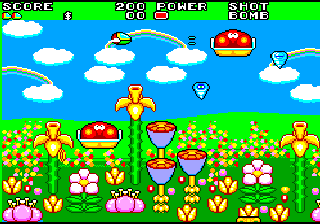
(Master System)
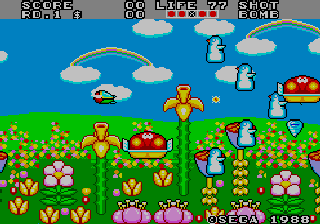
(Arcade)
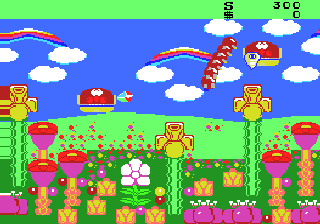
(MSX2)
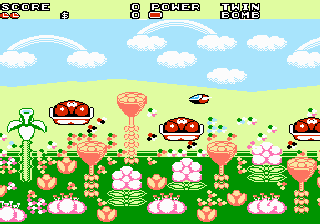
(Famicom)
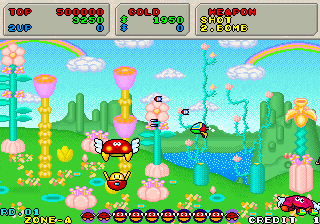
(PlayStation 2)
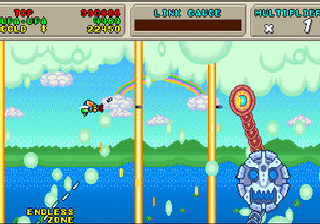
(Nintendo 3DS)
Master System (1987), Famicom (1988), MSX2 (1989), PlayStation 2 - SEGA AGES 2500: Vol. 33 [Master System & Arcade & Updated Arcade Port - Fantasy Zone II DX] (2008), Wii [1:1 Master System Port] (2008), Nintendo 3DS - [eshop 3D Fantasy Zone II: The Tears of Opa-Opa] (2014)
Super Fantasy Zone Super Fantasy Zone Super Fantasy Zone
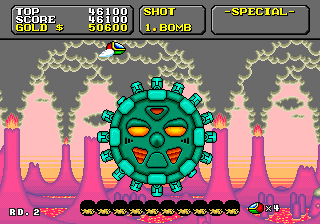
(Mega Drive/Genesis)
Mega Drive/Genesis (1992), PlayStation 2 - SEGA AGES 2500: Vol. 33 [1:1 Mega Drive Port] (2008), Wii [VC Mega Drive/Genesis Port] (2008) |
Spin-Offs:
Fantasy Zone: The Maze Fantasy Zone: The Maze Fantasy Zone: The Maze
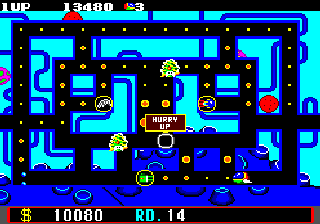
(Master System)
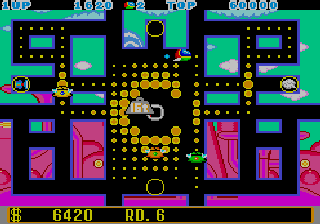
(Arcade)
Master System (1987), Arcade [Opa Opa] (1987), PlayStation 2 - SEGA AGES 2500: Vol. 33 [1:1 Master System & Arcade Port] (2008)
Galactic Protector Galactic Protector Galactic Protector
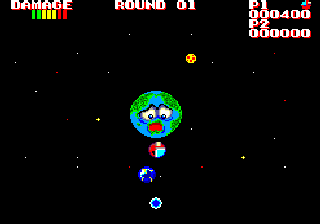
(Master System)
Master System (1988), PlayStation 2 - SEGA AGES 2500: Vol. 33 [1:1 Master System Port] (2008) |
| |
Hang-On

 = schlechte Umsetzung = schlechte Umsetzung  = ziemlich schlechte Umsetzung = ziemlich schlechte Umsetzung  = ziemlich gute Umsetzung = ziemlich gute Umsetzung  = gute Umsetzung = gute Umsetzung  = sehr gute Umsetzung = sehr gute Umsetzung
| First |
Umsetzungen |
Screenshot Comparison |
Der Arcade-Hit Hang-On von 1985 war SEGA´s Aushängeschild der Anfangsära des Master System. So wurde es auch gleich bei mehreren Master System Packs ins BIOS integriert und als Beilage verkauft sowie nur auf zwei damalige Systeme portiert.
Einzig die Hintergrundmusik während des Spielens und einige Animationen (z.B. beim Crashen) fehlen im Vergleich zur Arcade-Version des Arcadeboards (2x 68000er CPU @ 10MHz), ansonsten ist die Umsetzung auf die doch viel schwächere MS-Hardware gut gelungen (als Bonus kann man in der Master System Version im Vergleich zur Arcade-Version sogar schalten). Bei der SG-1000 Version müssen natürlich noch einige technische Abstriche gemacht werden - diese wurde auch in Hang-On II umbenannt, damit die Käufer diese nicht mit der im gleichen Jahr (1985) releasten Mark III Version verwechseln konnten.

Yu Suzuki´s Hang On war in der Arcade ein Spektakel aufgrund des stilechten Motorrad-Cabinets, auf Heimkonsolen scheint das Ganze hingegen nicht so gut zu funktionieren. So wurde dieser SEGA-Klassiker kaum auf andere Systeme portiert und es wurde ebenso wenig für aktuelle Nachfolger gesorgt. |
Hang-On
MSX (1986) 
PC-88 (1986) 
Shenmue (1/2) [Ingame Arcade Ver.]
Dreamcast/Xbox (1999 [1] / 2001/2002 [2])  |
|
Nachfolger:
Hang-On jr. Hang-On jr. Hang-On jr.
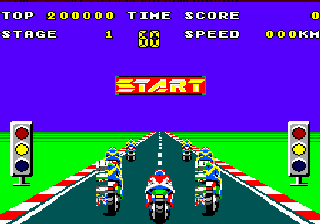
(Arcade)
Arcade (1986)
Super Hang-On Super Hang-On Super Hang-On
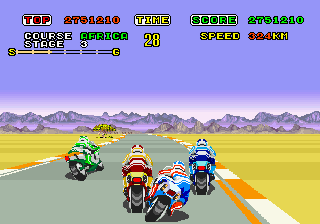
(Arcade)

(Amiga / Atari ST)
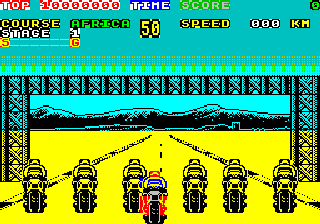
(Amstrad CPC / ZX Spectrum)
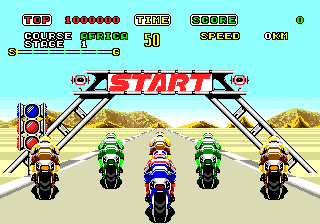
(Mega Drive / Genesis)
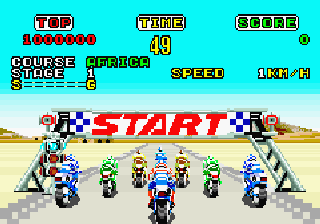
(GBA)
Arcade, Amstrad CPC, C64, Macintosh, ZX Spectrum (1987), Amiga, Atari ST, DOS (1988), Mega Drive, X68000 (1989), Windows - SEGA Smash Pack 2 [1:1 Arcade Port] (2000), GameBoy Advance - SEGA Arcade Gallery (2003), Wii [VC 1:1 Arcade Port] (2010), PlayStation 3/Xbox 360 [PSN/XBLA 1:1 Arcade Port] (2012), Nintendo 3DS [eShop 3D Super Hang-On] (2013)
Hang-On GP Hang-On GP Hang-On GP
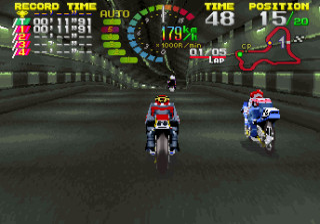
(Saturn)
SEGA Saturn (1995) |
| |
Out Run

 = schlechte Umsetzung = schlechte Umsetzung  = ziemlich schlechte Umsetzung = ziemlich schlechte Umsetzung  = ziemlich gute Umsetzung = ziemlich gute Umsetzung  = gute Umsetzung = gute Umsetzung  = sehr gute Umsetzung = sehr gute Umsetzung
| First |
Umsetzungen |
Screenshot Comparison |
Nimmt man die Power des 1986er Out Run Arcadeboards (2x 68000er CPU @ 12,5MHz) ist es klar, dass man beim Master System Port (der aber wie fast alle diese Ports noch im gleichen Jahr wie der Arcaderelease statt fand) auf einige Details verzichten muss. Insgesamt macht das Game aber einen ziemlich guten Eindruck und bietet sowohl den Fahrspaß des Originals als auch die gute Musik. Zwei Jahre später konnte man den Funracer sogar exklusiv in 3D mit der Master System 3D-Brille erleben. Alle Versionen nach dem perfekten SEGA Saturn Port bieten keinen originalen Ferrari Testarossa mehr (nur einen sehr ähnlich ausehenden Wagen mit anderem Logo und nun runden Rücklichtern), da SEGA die Lizenz nicht mehr inne hatte - diese wurde erst mit dem Release des Nachfolgers Out Run 2 erneuert.

Yu Suzki´s dritter Arcade-Hit war sowohl in den Spielhallen als auch zu Hause ein voller Erfolg. Das einfache Spielprinzip mit stimmungsvoller Musik aus dem Autoradio sorgte auf massig Systemen für Spielspaß und auch etliche Nachfolger und Ableger konnten somit die Fangemeinde erhalten. Es würde daher nicht verwundern, wenn alsbald ein Out Run 3 das Licht der Welt erblicken würde |
Out Run
Amstrad CPC (1987) 
ZX Spectrum (1987) 
Amiga (1988) 
Atari ST (1988) 
C64 (1988) 
MSX (1988) 
MSX2 (1988) 
DOS (1989) 
PC-Engine (1990) 
Game Gear (1991) 
Mega Drive/Genesis (1991) 
SEGA Ages Vol. 1 [Arcade Ver.]
SEGA Saturn (1996) 
Shenmue II [Ingame Arcade Ver.]
Dreamcast/Xbox (2001/2002) 
Out Run 2 [Ingame Arcade Ver.]
Xbox (2003) 
SEGA Arcade Gallery [Arcade Ver.]
GameBoy Advance (2003) 
SEGA Ages 2500: Vol. 13 / SEGA Classics Collection [Polygonal]
PlayStation 2 (2004/2005) 
3D Out Run [eShop Arcade Ver.]
Nintendo 3DS (2014)  |
|
Nachfolger:
Turbo Out Run Turbo Out Run Turbo Out Run
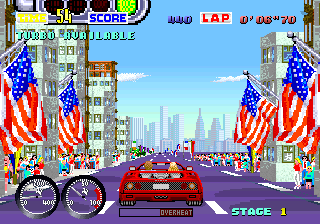
(Arcade)
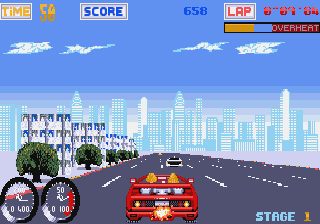
(Amiga / Atari ST)
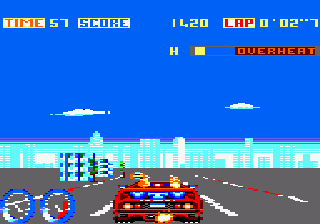
(Amstrad CPC)
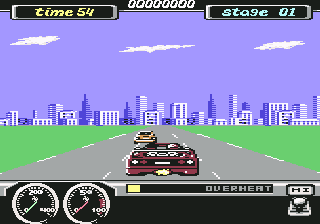
(C64)
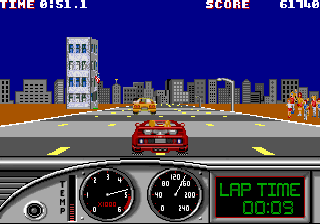
(DOS)
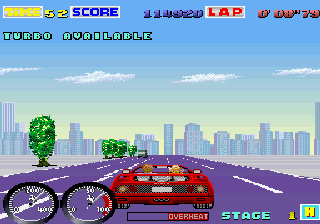
(FM-Towns)
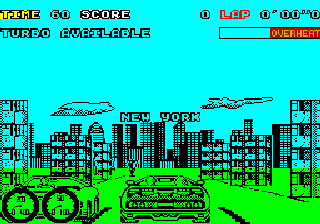
(ZX Spectrum)
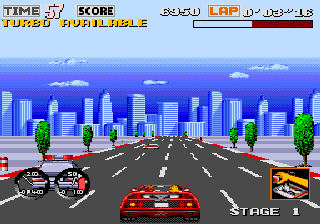
(Mega Drive / Genesis)
Arcade, Amiga, Amstrad CPC, Atari ST, C64, FM-Towns, ZX Spectrum (1989), DOS (1990), Mega Drive / Genesis (1992)
Out Runners Out Runners Out Runners
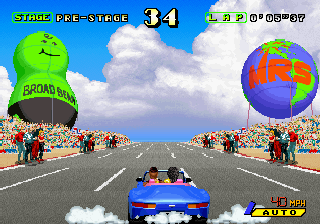
(Arcade)
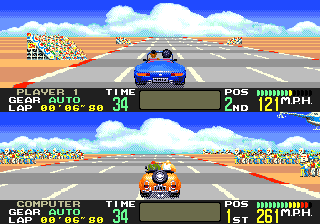
(Mega Drive / Genesis)
Arcade (1993), Mega Drive / Genesis (1994)
Out Run 2 Out Run 2 Out Run 2
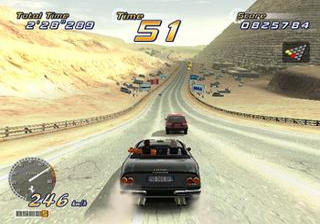
(Arcade)
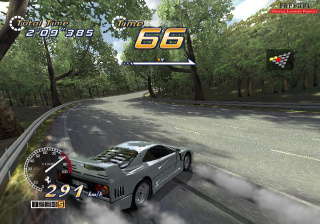
(Xbox)
Arcade (2003), Xbox (2004)
Out Run 2 SP / Out Run 2006: Coast 2 Coast / Out Run Online Arcade Out Run 2 SP / Coast 2 Coast / Online Arcade Out Run 2 SP / Coast 2 Coast / Online Arcade
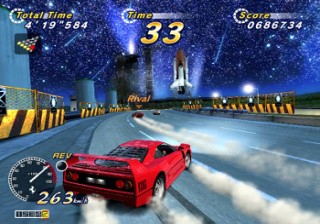
(Arcade)
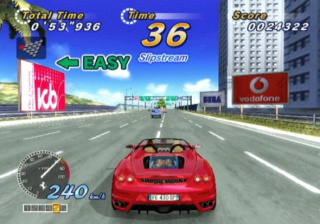
(PS2)
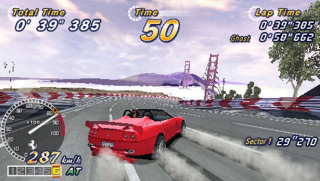
(PSP)
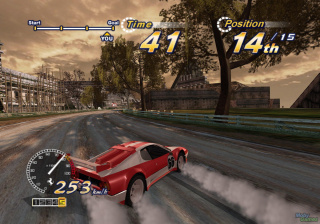
(PC)
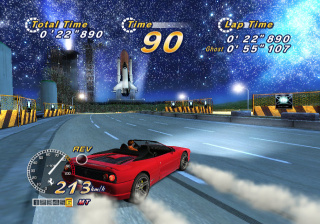
(Xbox)
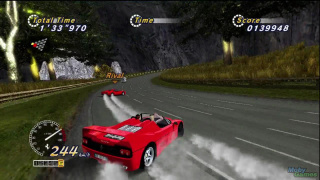
(PS3 / 360)
Arcade - Out Run 2 SP (2004), PlayStation 2 / PlayStation Portable / Windows / Xbox - Out Run 2006: Coast 2 Coast (2005), PlayStation 3/Xbox 360 [PSN/XBLA - Out Run Online Arcade] (2009) |
Spin-Offs:
Battle Out Run Battle Out Run Battle Out Run
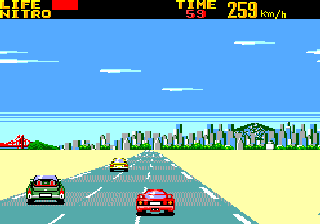
(Master System)
Master System (1989)
Out Run Europa Out Run Europa Out Run Europa
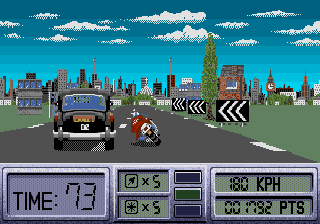
(Amiga / Atari ST)
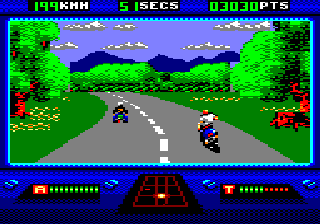
(Amstrad CPC)
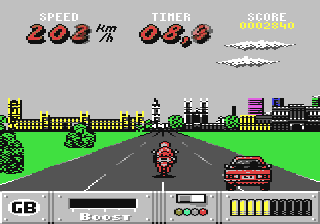
(C64)
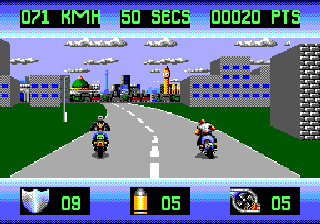
(Master System / Game Gear)
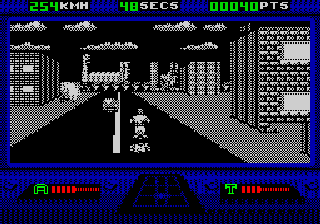
(ZX Spectrum)
Amiga, Amstrad CPC, Atari ST, Commodore C64, Game Gear, Master System, ZX Spectrum (1991)
Out Run 2019 Out Run 2019 Out Run 2019
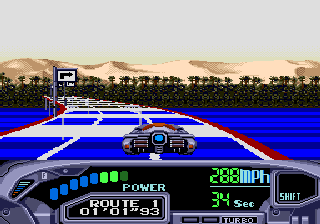
(Mega Drive / Genesis)
Mega Drive / Genesis (1993) |
| |
Phantasy Star
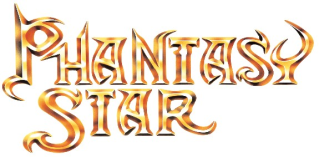
| First |
Umsetzungen |
Screenshot Comparison |
Im Gegensatz zu alle den anderen Erstlingswerken handelt es sich bei Phantasy Star nicht um eine Arcadeumsetzung, sondern um eine Exklusiventwicklung, die zudem beim Release 1987 Maßstäbe setzte.
Nach dem Erfolg des japanophilen RPG´s Dragon Quest in Nippon entwickelten auch SEGA und Nintendo JRPG´s für Master System bzw. NES. Während SEGA sich selbst um ein solches Konsolen-RPG kümmerte, setzte man bei Nintendo auf Squares Final Fantasy.
Dank der ausgeklügelten Stories, passenden Charakteren, einer großen und frei erkundbaren Weltkarte, interaktiven Städten sowie Monster verseuchten Höhlen setzte dieser Titel die Messlatte für zukünftige Rollenspiele auf Konsolen. Zudem bot Phantasy Star als eines der ersten Konsolenspiele eine interne Batterie zum Speichern des Spielstandes.
Aufgrund dieser Entwicklungsleistung wurde Phantasy Star zur damaligen Zeit entgegen den anderen Spielen dieser Seite auch nicht für SEGA-fremde Systeme umgesetzt.
Nach dem Ende SEGA´s als Konsolenhersteller wanderte SonicTeam´s RPG-Spektakel dann auf allerlei Systeme in Form von Phantasy Star Online/Phantasy Star Universe bzw. auch portabel als Phantasy Star Zero/Phantasy Star Portable. |
Phantasy Star Fukkokuban
Mega Drive (1994) 1:1 Port
Phantasy Star Collection
SEGA Saturn / GameBoy Advance (1998 / 2002) 1:1 Ports
SEGA AGES 2500: Vol.1
PlayStation 2 (2003) Updated Remake
SEGA AGES 2500: Vol.32
PlayStation 2 (2008) 1:1 Port
Phantasy Star
Wii (2009) Virtual Console 1:1 Master System Port
Mega Drive Ultimate Collection
PlayStation 3 / Xbox 360 (2009) 1:1 Master System Port [Bonus Game] |
|
Nachfolger:
Phantasy Star II Phantasy Star II Phantasy Star II
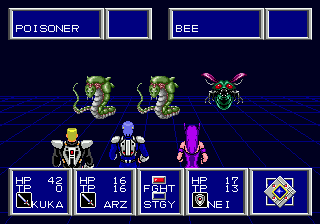
(Mega Drive / Genesis)
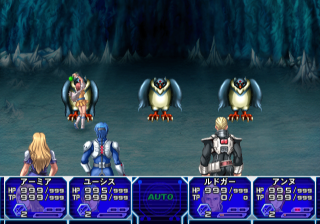
(PlayStation 2)
Mega Drive / Genesis (1989), SEGA Saturn / GameBoy Advance - Phantasy Star Collection [1:1 Mega Drive/Gensis Port] (1998/2002), PlayStation 2 - SEGA AGES 2500: Vol.17 [Updated Remake] (2005), PlayStation 2/Playstation Portable - Mega Drive Collection [1:1 Mega Drive Port] (2006), PlayStation 2 - SEGA AGES 2500: Vol.32 [1:1 Mega Drive Port], Wii [VC 1:1 Mega Drive/Genesis Port] (2008), Xbox 360 [XBLA 1:1 Mega Drive/Gensis Port] (2009), PlayStation 3/Xbox360 - Mega Drive Ultimate Collection [1:1 Mega Drive/Genesis Port] (2009), Windows [Steam 1:1 Mega Drive/Genesis Port] (2012)
Phantasy Star III Phantasy Star III Phantasy Star III
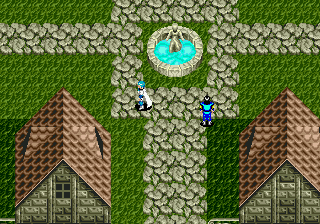
(Mega Drive / Genesis)
Mega Drive / Genesis (1990), SEGA Saturn / GameBoy Advance - Phantasy Star Collection [1:1 Mega Drive/Genesis Port] (1998/2002), PlayStation 2/PlayStation Portable - Mega Drive Collection [1:1 Mega Drive Port] (2006), PlayStation 2 - SEGA AGES 2500: Vol.32 [1:1 Mega Drive Port], Wii [VC 1:1 Mega Drive/Genesis Port] (2008), PlayStation 3/Xbox360 - Mega Drive Ultimate Collection [1:1 Mega Drive Port] (2009), Windows [Steam 1:1 Mega Drive/Genesis Port] (2012)
Phantasy Star IV Phantasy Star IV Phantasy Star IV
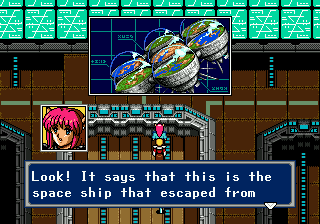
(Mega Drive / Genesis)
Mega Drive / Genesis (1993), SEGA Saturn - Phantasy Star Collection [1:1 Mega Drive/Genesis Port] (1998), PlayStation 2/PlayStation Portable - Mega Drive Collection [1:1 Mega Drive Port] (2006), PlayStation 2 - SEGA AGES 2500: Vol.32 [1:1 Mega Drive Port], Wii [VC 1:1 Mega Drive/Genesis Port] (2008), PlayStation 3/Xbox360 - Mega Drive Ultimate Collection [1:1 Mega Drive Port] (2009), Windows [Steam 1:1 Mega Drive Port] (2012)
Phantasy Star Online Phantasy Star Online Phantasy Star Online
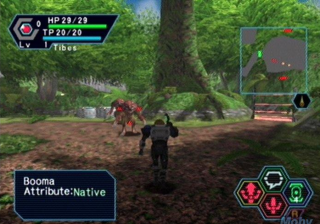
(Dreamcast)
Dreamcast (2000), Windows PC (2001), GameCube/Xbox - Phantasy Star Online 1 & 2 [Updated Ver.] (2003), GameCube - Phantasy Star Online 1 & 2 Plus [Updated Ver.] (2004), Windows Download - Phantasy Star Online: Blue Burst [Updated Ver.] (2005)
Phantasy Star Online Ver. 2 Phantasy Star Online Ver. 2 Phantasy Star Online Ver. 2
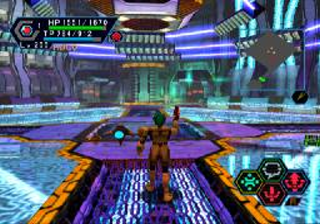
(Dreamcast)
Dreamcast (2001), GameCube/Xbox - Phantasy Star Online 1 & 2 [Updated Ver.] (2003), GameCube - Phantasy Star Online 1 & 2 Plus [Updated Ver.] (2004), Windows Download - Phantasy Star Online: Blue Burst [Updated Ver.] (2005)
Phantasy Star Universe Phantasy Star Universe Phantasy Star Universe
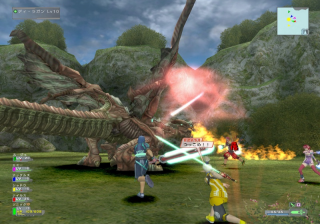
(PC)
PlayStation 2, Windows PC, Xbox 360 (2006), PlayStation 2, Windows PC, Xbox 360 - Phantasy Star Universe: Ambition of the Illuminus [Updated Version] (2007)
Phantasy Star Zero Phantasy Star Zero Phantasy Star Zero
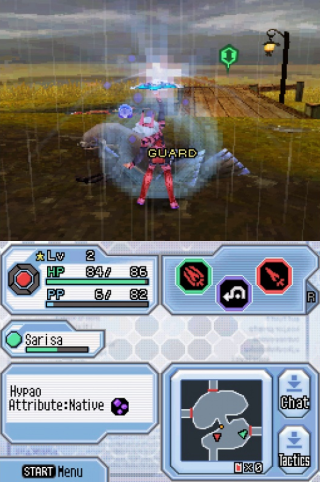
(DS)
Nintendo DS (2009) |
Spin-Offs:
Phantasy Star Text Adventures [8 Games: Kinds no Boken, Shilka, Amia, Nei, Huey, Anne, Eusis [Yushi], Rudger] Phantasy Star: Text Adventure Phantasy Star: Text Adventure

(Mega Drive)
Mega Drive [SEGAnet Download] (1990/1991), Mega-CD - Game no Kanzume Vol. 1 [Amia, Huey, Shilka, Yushi] / Game no Kanzume Vol. 2 [Anne, Kinds, Nei, Rudger] (1994), PlayStation 2 - SEGA AGES 2500: Vol.32 [1:1 Mega Drive Ports] (2008)
Phantasy Star Adventure / Phantasy Star Gaiden Phantasy Star Adventure Phantasy Star Adventure
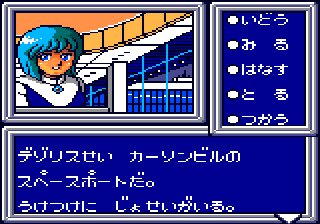
(Game Gear)
Phantasy Star Gaiden
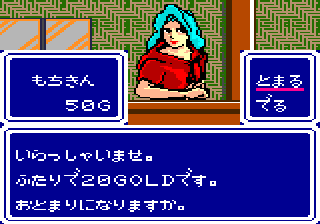
(Game Gear)
Game Gear (1992), PlayStation 2 - SEGA AGES 2500: Vol.32 [1:1 Game Gear Ports] (2008)
Phantasy Star Online Episode III: C.A.R.D. Revolution Phantasy Star Online Episode III: C.A.R.D. Revolution Phantasy Star Online Episode III: C.A.R.D. Revolution

(GameCube)
GameCube (2004)
Phantasy Star Portable Phantasy Star Portable Phantasy Star Portable
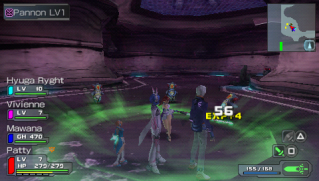
(PSP)
PlayStation Portable (2009)
Phantasy Star Portable 2 Phantasy Star Portable 2 Phantasy Star Portable 2
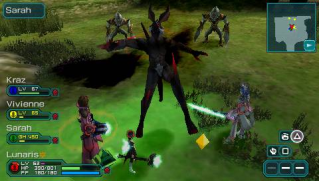
(PSP)
PlayStation Portable (2009), PlayStation Portable - Phantasy Star Portable 2 Infinity [Update] (2011) |
| |
Shinobi
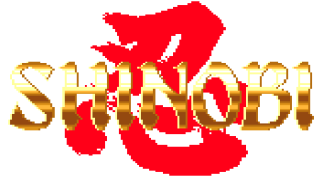
 = schlechte Umsetzung = schlechte Umsetzung  = ziemlich schlechte Umsetzung = ziemlich schlechte Umsetzung  = ziemlich gute Umsetzung = ziemlich gute Umsetzung  = gute Umsetzung = gute Umsetzung  = sehr gute Umsetzung = sehr gute Umsetzung
| First |
Umsetzungen |
Screenshot Comparison |
Mussten die bisher genannten Master System Ports im Vergleich zu ihrem Arcade-Pendant in vielen Belangen heruntergeschraubt werden, so gelang es SEGA beim Shinobi-Port abgesehen von den grafischen Finessen des System16-Arcadeboards sogar, einige nützliche Dinge hinzuzufügen. Neben einem für den Spielablauf unabdingbaren Lebensbalken kann Shinobi Joe Musashi nun auch weitere Waffen wie Pistolen, Peitschen oder Bomben verwenden. Zudem kann man die Level nun auch beenden, ohne alle Geiseln befreit zu haben, auch wenn einem dadurch einige PowerUps durch die Lappen gehen.

SEGA´s Ninja hält den Rekord der Klassiker in Sachen Umsetzungen und vor allem Nachfolger und wird mit Sicherheit noch das ein oder andere mal erneut auftauchen. |
Shinobi
Amiga (1989) 
Amstrad CPC (1989) 
Atari ST (1989) 
C64 (1989) 
DOS (1989) 
MSX (1989) 
NES (1989) 
PC-Engine (1989) 
ZX Spectrum (1989) 
Sonic´s Ultimate Genesis Collection [unlockable Arcade Ver.]
PS3/360 (2009) 
Wii [Virtual Console Arcade Ver.] (2009) 
Xbox 360 [XBLA Arcade Ver.] (2009)  |
|
Nachfolger:
Shadow Dancer: The Secret of Shinobi Shadow Dancer Shadow Dancer
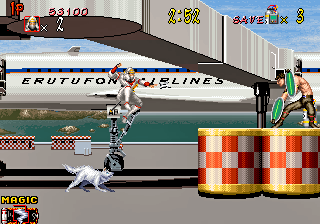
(Arcade)
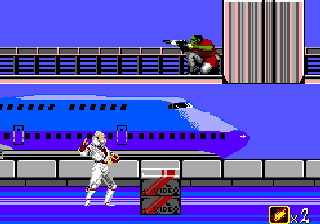
(Master System)
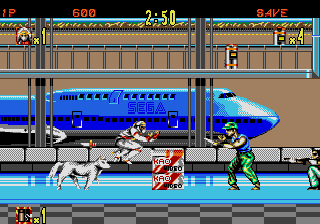
(Amiga / Atari ST)
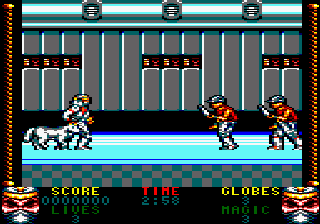
(Amstrad CPC / ZX Spectrum)
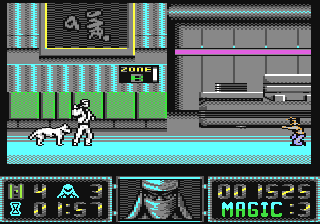
(C64)
Arcade (1989), Amiga / Amstrad CPC / Atari ST / C64 / Master System / ZX Spectrum (1991)
The Revenge of Shinobi / The Super Shinobi The Revenge of Shinobi / The Super Shinobi The Revenge of Shinobi / The Super Shinobi
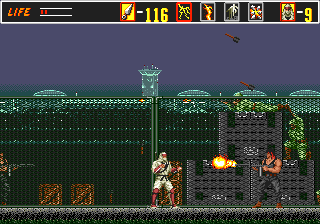
(Mega Drive / Genesis / Arcade / PlayStation 3 / Wii / Windows)
Mega Drive / Genesis / Mega-Tech (1989), Windows / Dreamcast - SEGA Smash Pack [1:1 Mega Drive/Genesis Port] (1998/2001), Wii [VC 1:1 Mega Drive/Genesis Port] (2009), PlayStation 3 / Windows - [PSN/Steam 1:1 Mega Drive/Genesis Port] (2012)
The Cyber Shinobi The Cyber Shinobi The Cyber Shinobi
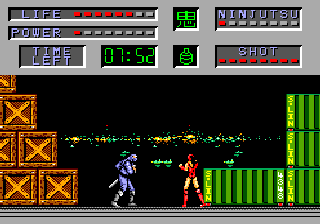
(Master System)
Master System (1990)
Shadow Dancer: The Secret of Shinobi (different to MS Version) Shadow Dancer: The Secret of Shinobi Shadow Dancer: The Secret of Shinobi
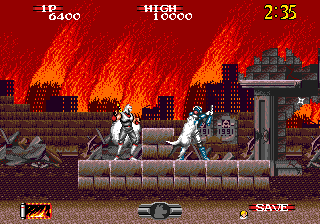
(Mega Drive / Genesis / PlayStation 2 / PlayStation Portable / Wii / Windows)
Mega Drive / Genesis (1990), PlayStation 2 / PlayStation Portable - SEGA Genesis Collection [1:1 Genesis Port] (2006), Wii / Windows [VC/Steam 1:1 Mega Drive/Genesis Port] (2010)
Shinobi / The GG Shinobi Shinobi / The GG Shinobi Shinobi / The GG Shinobi
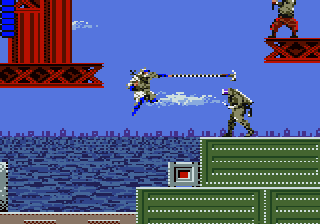
(Game Gear / Nintendo 3DS)
Game Gear (1991), Nintendo 3DS [eshop 1:1 Game Gear Port] (2012)
Shinobi II: The Silent Fury / The GG Shinobi 2 Shinobi II / The GG Shinobi 2 Shinobi II / The GG Shinobi 2

(Game Gear)
Game Gear (1992)
Shinobi III: Return of the Ninja Master / The Super Shinobi II Shinobi III: Return of the Ninja Master / The Super Shinobi II Shinobi III: Return of the Ninja Master / The Super Shinobi II
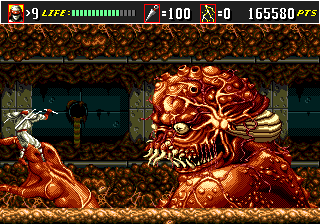
(Mega Drive / Genesis / Nintendo 3DS / PlayStation 2 / PlayStation 3 / PlayStation Portable / Wii / Windows)
Mega Drive / Genesis (1993), PlayStation 2 / PlayStation Portable - SEGA Genesis Collection [1:1 Genesis Port] (2006), Wii [VC 1:1 Mega Drive/Genesis Port] (2007), PlayStation 3 / PlayStation Portable - Sonic´s Ultimate Genesis Collection [1:1 Genesis Port] (2009), Windows [Steam 1:1 Mega Drive/Genesis Port] (2010), Nintendo 3DS [eshop 1:1 Mega Drive/Genesis Port] (2013)
Shinobi X / Shinobi Legions / Shin Shinobi Den Shinobi X / Shinobi Legions / Shin Shinobi Den Shinobi X / Shinobi Legions / Shin Shinobi Den
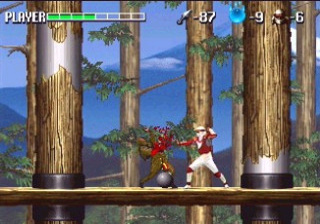
(SEGA Saturn)
SEGA Saturn (1995)
Shinobi Shinobi Shinobi
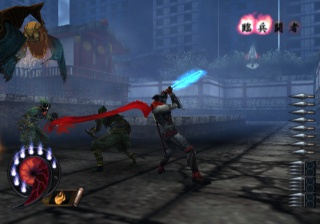
(PlayStation 2 / PlayStation 3)
PlayStation 2 (2002), PlayStation 3 [PSN 1:1 PlayStation 2 Port] (2012)
The Revenge of Shinobi (different to MD Version) The Revenge of Shinobi The Revenge of Shinobi

(GameBoy Advance)
GameBoy Advance (2002)
Shinobi 3D Shinobi 3D Shinobi 3D
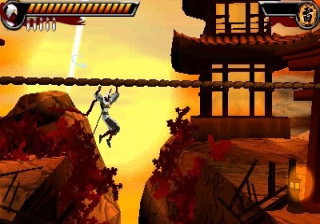
(Nintendo 3DS)
Nintendo 3DS (2011) |
Spin-Offs:
Nightshade / Kunoichi Nightshade / Kunoichi Nightshade / Kunoichi
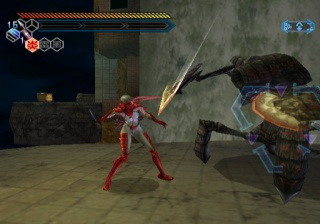
(PlayStation 2)
PlayStation 2 (2004) |
| |
Space Harrier

 = schlechte Umsetzung = schlechte Umsetzung  = ziemlich schlechte Umsetzung = ziemlich schlechte Umsetzung  = ziemlich gute Umsetzung = ziemlich gute Umsetzung  = gute Umsetzung = gute Umsetzung  = sehr gute Umsetzung = sehr gute Umsetzung
| First |
Umsetzungen |
Screenshot Comparison |
Wie schon beim technisch ähnlichen After Burner dauerte es bis zur 32Bit-Ära, bis die Arcade-Version von 1985 perfekt portiert werden konnte, was einem veranschaulicht, wieviel Vorsprung die Arcadeboards damals vor den Heimkonsolen hatten.
Der Master System Port ist dennoch unter den 8Bit-Konsolen/PC´s der damaligen Zeit die beste Version, konnte man hier das unglaubliche Geschwindigkeitsgefühl wenigstens noch halbwegs hinüber retten.

Wie schon bei Fantasy Zone gab es auch von Yu Suzuki´s Space Harrier auch keine wirklichen Nachfolger (außer auf Mega Drive), obwohl der erste Teil auf so ziemlich jede Hardware umgesetzt wurde. Dieses doch sehr einfache Spielprinzip will wohl heute nicht mehr so funktionieren. |
Space Harrier
C64 (1986) 
ZX Spectrum (1986) 
Amstrad CPC (1987) 
C64 (1987) 
Fujitsu FM-7 (1987) 
PC-6001 (1987) 
PC-8801 (1987) 
X68000 (1987) 
Amiga (1988) 
Atari ST (1988) 
MZ-700 (1988) 
PC-Engine (1988) 
X1 (1988) 
DOS (1989) 
Famicom (1989) 
Game Gear (1991) 
32X (1994) 
SEGA Ages Vol. 1
SEGA Saturn (1995) 
Shenmue 1&2 [Ingame Arcade Ver.]
Dreamcast/Xbox (2001/2002) 
SEGA Arcade Gallery [Arcade Ver.]
GameBoy Advance (2003) 
SEGA AGES 2500: Vol. 4 [Polygonal]
PlayStation 2 (2003) 
SEGA AGES 2500: Vol. 20 [MS & Arc. Ver.]
PlayStation 2 (2005) 
Wii [VC MS Ver.] (2008) 
Sonic´s Ultimate Genesis Collection [unlockable Arcade Ver.]
PS3/360 (2009) 
Wii [VC Arcade Ver.] (2009) 
3D Space Harrier [eshop Arcade Ver.]
Nintendo 3DS (2012)  |
|
Nachfolger:
Space Harrier 3D (different to normal MS Version) Space Harrier 3D Space Harrier 3D
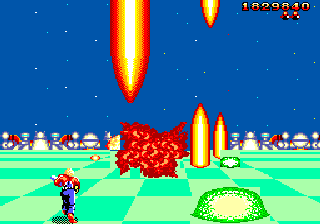
(Master System / PlayStation 2 / PlayStation 3)
Master System (1988), PlayStation 2 - SEGA AGES 2500: Vol. 20 [1:1 Master System Port] (2005), PlayStation 3 [PSN PlayStation 2 Port] (2012)
Space Harrier II Space Harrier II Space Harrier II
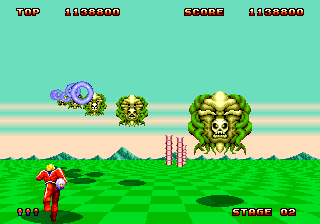
(Mega Drive / Genesis / Arcade / PlayStation 2 / PlayStation 3 / Wii / Windows)

(Amiga / Atari ST)
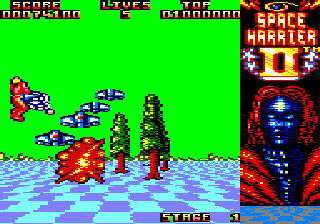
(Amstrad CPC)

(C64)

(ZX Spectrum)
Mega Drive / Genesis / Mega-Tech (1988/1989), Amiga / Amstrad CPC / Atari ST / C64 / ZX Spectrum (1990), PlayStation 2 - SEGA AGES 2500: Vol. 20 [1:1 Mega Drive Port] (2005), Wii [VC 1:1 Mega Drive/Genesis Port] (2006), Windows [Steam 1:1 Mega Drive/Genesis Port] (2010), PlayStation 3 [PSN PlayStation 2 Port] (2012) |
Spin-Offs:
Planet Harriers Planet Harriers Planet Harriers
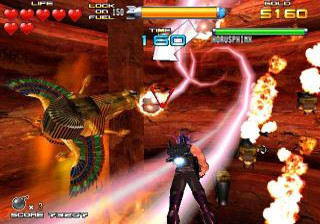
(Arcade)
Arcade (2000)
Typing Space Harrier Typing Space Harrier Typing Space Harrier
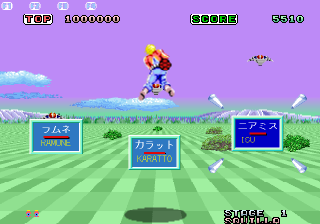
(Windows)
Windows (2002) |
| |
Wonder Boy

 = schlechte Umsetzung = schlechte Umsetzung  = ziemlich schlechte Umsetzung = ziemlich schlechte Umsetzung  = ziemlich gute Umsetzung = ziemlich gute Umsetzung  = gute Umsetzung = gute Umsetzung  = sehr gute Umsetzung = sehr gute Umsetzung
| First |
Umsetzungen |
Screenshot Comparison |
Da die Arcade-Version auf dem System 2 Board (1986 / ebenfalls Z80 based) läuft, ist die Umsetzung auf SEGA´s Master System (1987) nahezu identisch mit Ausnahme der Farben, wobei die Master System Version zudem sehr viel flüssiger läuft als die schlecht programmierte SG-1000 Version (1986) und sogar einige exklusive Levels bietet.
SG-1000:  Master System: Master System: 
Gerade durch die Nachfolger hat der Wunderjunge eine große Fangemeinde aufgebaut. Zwar wurden die Wonder Boy Spiele nicht von SEGA sondern von Westone programmiert, dennoch hatte Westone (ehemals Escape) eine exklusive Vereinbarung mit SEGA, welche die Rechte am Namen und Charakteren an SEGA übertrug. Nebenbei hatte Westone auch noch eine Lizenz-Vereinbarung mit Hudson Soft, die dann die Spiele unter anderem Namen und mit anderen Charakteren auf weitere Plattformen brachte. In Brasilien verwendete der Publisher TecToy auf dem Master System anstatt des Wonder Boy Charakters einen Charakter aus der in Brasilien beliebten Comicserie rund um die Heldin Monica. Releast wurden Monica: No Castelo do Dragao (= Wonder Boy in Monster Land), Turma da Monica: Em o Resgate (= Wonder Boy III: The Dragon´s Trap) und Turma da Monica na Terra dos Monstros (= Wonder Boy in Monster World). |
Wonder Boy
Amstrad CPC (1987) 
C64 (1987) 
ZX Spectrum (1987) 
Game Gear (1990) 
Wii [VC MS Ver.] (2008) 
SEGA AGES 2500: Vol. 29 [ARC/MS/GG/SG]
PlayStation 2 (2007) 
Adventure Island / Takahashi-Meijin no Bouken Jima
NES/Famicom/MSX (1986/1987)  |
|
Nachfolger:
Wonder Boy in Monster Land / Super Wonder Boy: Monster World Wonder Boy in Monster Land / Super Wonder Boy: Monster World Wonder Boy in Monster Land / Super Wonder Boy: Monster World
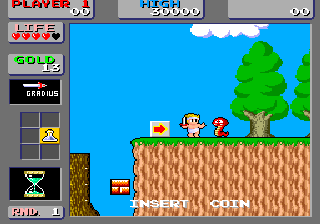
(Arcade / PlayStation 2 / PlayStation 3 / Wii / Xbox 360)
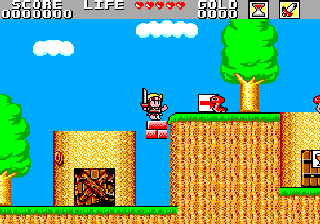
(Master System / PlayStation 2 / Wii)
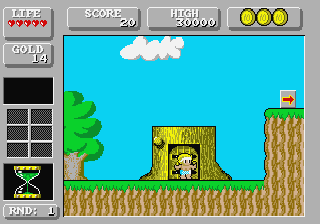
(Amiga / Atari ST)
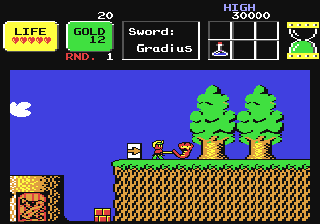
(C64)
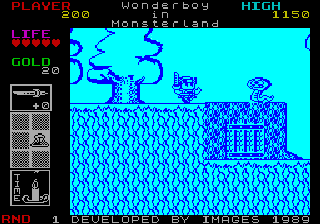
(Amstrad CPC / ZX Spectrum)
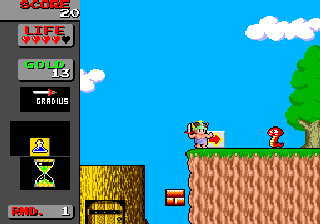
(PC-Engine)
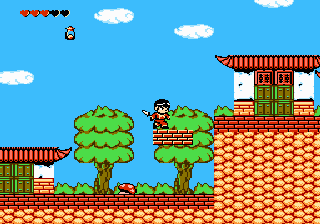
(Famicom)
Arcade (1987), PC-Engine - Bikkuriman World (1987), Master System (1988), Famicom - Saiyuuki World (1988), Amiga / Amstrad CPC / Atari ST / C64 / ZX Spectrum (1989), PlayStation 2 - SEGA AGES 2500: Vol. 29 [1:1 Master System & Arcade Port] (2007), Wii [VC 1:1 Master System Port] (2008), Wii [VC 1:1 Arcade Port] (2011), PlayStation 3/Xbox 360 [PSN/XBLA 1:1 Arcade Port] (2012)
Wonder Boy III: Monster Lair Wonder Boy III: Monster Lair Wonder Boy III: Monster Lair
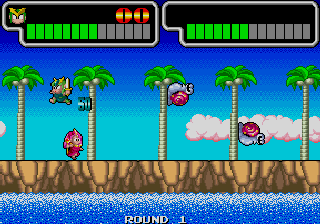
(Arcade / PlayStation 2)
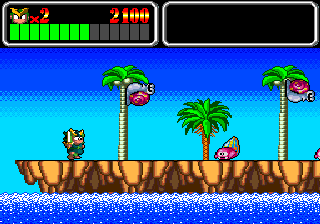
(PC-Engine/Turbografx CD / Wii)
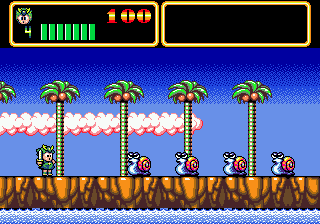
(Mega Drive / Genesis / Wii / Windows)
Arcade (1988), PC-Engine CD / Turbografx CD (1989), Mega Drive / Genesis (1990), PlayStation 2 - SEGA AGES 2500: Vol. 20 [1:1 Mega Drive/Genesis & Arcade Port] (2005), Wii [VC 1:1 Turbografx CD Port] (2007), Wii [VC 1:1 Mega Drive/Genesis Port] (2009), Windows - [Steam 1:1 Mega Drive/Genesis Port] (2011)
Wonder Boy III: The Dragon´s Trap Wonder Boy III: The Dragon´s Trap Wonder Boy III: The Dragon´s Trap
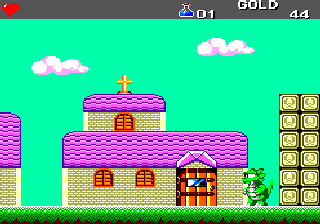
(Master System / PlayStation 2 / Wii)

(Game Gear / PlayStation 2)
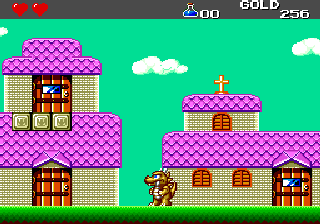
(PC-Engine/Turbografx / Wii)
Master System (1989), PC-Engine/Turbografx - Adventure Island/Dragon´s Curse (1990), Game Gear - Wonder Boy: The Dragon´s Trap / Monster World II: Dragon no Wana (1992), PlayStation 2 - SEGA AGES 2500: Vol. 20 [1:1 Master System & Game Gear Ports] (2005), Wii [VC 1:1 Turbografx Port] (2007), Wii [VC 1:1 Master System Port] (2009)
Wonder Boy in Monster World / Wonder Boy V: Monster World III Wonder Boy in Monster World Wonder Boy in Monster World
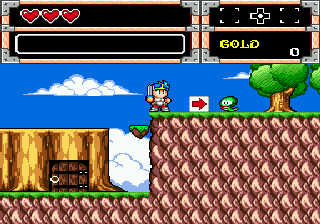
(Mega Drive / Genesis / PlayStation 2 / PlayStation 3 / Wii / Windows / Xbox 360)
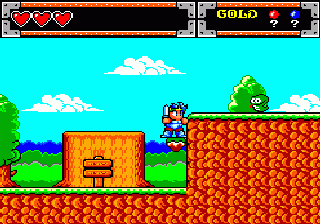
(Master System / PlayStation 2)
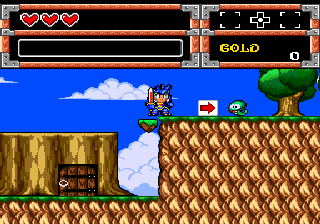
(PC-Engine / Wii)
Mega Drive / Genesis (1991), Master System (1993), PC-Engine CD - Dynastic Hero (1994), PlayStation 2 - SEGA AGES 2500: Vol. 20 [1:1 Mega Drive & Master System Ports] (2005), Wii [VC 1:1 Mega Drive/Genesis & PC-Engine CD Ports] (2007), PlayStation 3 / Windows / Xbox 360 [PSN/Steam/XBLA 1:1 Mega Drive/Genesis Port] (2012)
Monster World IV Monster World IV Monster World IV
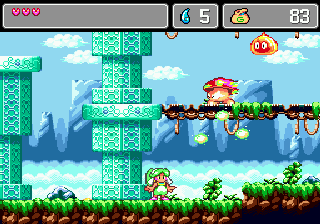
(Mega Drive / PlayStation 2 / PlayStation 3 / Wii / Xbox 360)
Mega Drive (1994), PlayStation 2 - SEGA AGES 2500: Vol. 20 [1:1 Mega Drive Port] (2005), Wii [VC 1:1 Mega Drive Port] (2008/2012), PlayStation 3 / Xbox 360 [PSN/XBLA 1:1 Mega Drive Port] (2012) |
| |
Die Verlierer der ersten SEGA Generation
Neben den bisher genannten Titeln, die auf massig Systeme portiert wurden und die auch einige Nachfolger (teils bis heute) erhielten, gab es aber auch 2 klare Verlierer der ersten SEGA Generation rund um die 8Bit-Konsolen.
So wurde der eigentlich als Maskottchen entwickelte Alex Kidd von Sonic mit der 16Bit-Generation abgelöst und der Zillion-Held verschwand sogar ganz und gar lautlos in die ewigen Jagdgründe der Videospielgeschichte, obwohl beide die Zutaten für eine lange und erfolgreiche Geschichte wie die anderen hier genannten Spiele hatten.
Alex Kidd

Zillion

|
